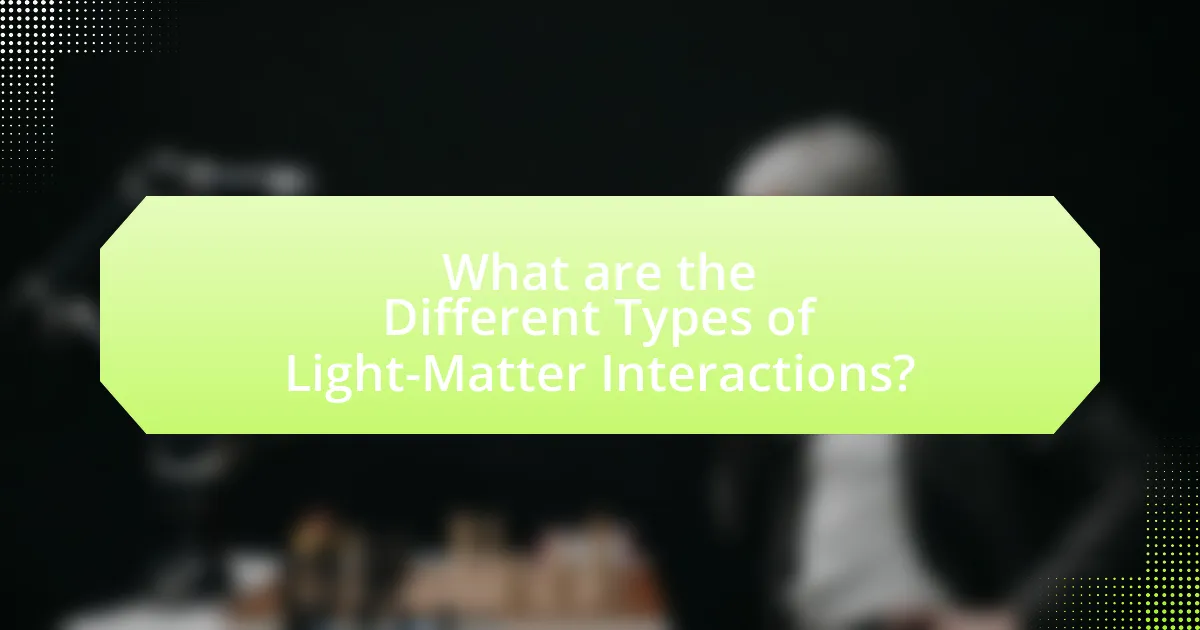The article focuses on the interaction between light and matter, a fundamental concept in physics that encompasses processes such as absorption, emission, scattering, and transmission of light by various materials. It explains how these interactions are governed by principles of quantum mechanics and electromagnetic theory, influencing phenomena like photosynthesis, color perception, and technological applications in spectroscopy, imaging, and energy conversion. The article further explores the significance of these interactions in everyday life and their role in scientific advancements, highlighting practical applications in telecommunications, medical imaging, and renewable energy technologies. Additionally, it discusses best practices for studying light-matter interactions and the innovations driven by advancements in this field.

What is the Interaction Between Light and Matter?
The interaction between light and matter involves the absorption, emission, and scattering of light by particles. When light encounters matter, it can be absorbed, leading to an increase in the energy of the matter, or it can be scattered, changing the direction of the light without altering its energy. This interaction is fundamental to various phenomena, such as photosynthesis in plants, where light is absorbed by chlorophyll, and the colors we perceive, which result from the scattering of light by objects. The principles governing these interactions are described by quantum mechanics and electromagnetic theory, which explain how photons interact with electrons in atoms and molecules.
How do light and matter interact on a fundamental level?
Light and matter interact fundamentally through processes such as absorption, emission, and scattering. When light encounters matter, photons can be absorbed by atoms or molecules, causing electrons to transition to higher energy levels. This absorption process is quantified by the Beer-Lambert law, which describes how the intensity of light decreases as it passes through a medium. Conversely, when electrons return to their original energy states, they emit photons, resulting in light emission, which is the basis for phenomena like fluorescence and phosphorescence. Additionally, scattering occurs when light changes direction upon interacting with particles, which is described by Rayleigh and Mie scattering theories. These interactions are essential in various applications, including spectroscopy, imaging, and the development of optical devices.
What are the basic principles governing light-matter interactions?
The basic principles governing light-matter interactions include absorption, emission, scattering, and transmission of light by matter. Absorption occurs when matter takes in photons, leading to electronic transitions within atoms or molecules. Emission happens when excited electrons return to lower energy states, releasing photons. Scattering involves the redirection of light by particles in matter, which can change the light’s direction and intensity. Transmission refers to the passage of light through a medium without being absorbed. These principles are foundational in fields such as optics and quantum mechanics, where they explain phenomena like the color of objects and the behavior of lasers.
How do different types of matter affect light?
Different types of matter affect light through processes such as reflection, refraction, absorption, and scattering. For instance, transparent materials like glass allow light to pass through with minimal absorption, bending the light’s path due to refraction, as described by Snell’s Law. In contrast, opaque materials, such as metals, reflect most of the light that hits them, while absorbing some wavelengths, which is why they appear shiny. Additionally, materials like water can scatter light, causing phenomena such as the blue color of the ocean due to Rayleigh scattering. These interactions are governed by the material’s atomic and molecular structure, which determines how light interacts with it.
Why is the interaction between light and matter important?
The interaction between light and matter is important because it underpins numerous physical phenomena and technological applications. This interaction governs processes such as absorption, reflection, and transmission of light, which are essential for understanding the behavior of materials and the development of optical devices. For instance, the principles of light-matter interaction are fundamental in spectroscopy, allowing scientists to analyze the composition of substances by observing how they absorb or emit light. Additionally, technologies like solar cells and lasers rely on these interactions to convert light into energy or amplify it for various applications.
What role does this interaction play in everyday phenomena?
The interaction between light and matter plays a crucial role in everyday phenomena by enabling visibility and the perception of colors. This interaction occurs when light waves collide with matter, leading to absorption, reflection, or transmission of light. For instance, when sunlight hits a leaf, chlorophyll absorbs specific wavelengths, reflecting green light, which is why leaves appear green. This fundamental concept underlies various daily experiences, such as seeing objects, photosynthesis in plants, and the functioning of cameras and screens. The principles of light-matter interaction are also essential in technologies like fiber optics and solar panels, demonstrating their pervasive impact on modern life.
How does it contribute to scientific advancements?
The interaction between light and matter significantly contributes to scientific advancements by enabling the development of technologies such as lasers, spectroscopy, and imaging systems. These technologies have transformed fields like medicine, telecommunications, and materials science. For instance, lasers are crucial in surgical procedures, allowing for precision and minimally invasive techniques, which have improved patient outcomes. Spectroscopy techniques, which analyze the interaction of light with matter, are essential in chemical analysis and have led to breakthroughs in understanding molecular structures and reactions. Furthermore, advancements in imaging systems, such as MRI and CT scans, rely on the principles of light-matter interaction, enhancing diagnostic capabilities in healthcare.

What are the Different Types of Light-Matter Interactions?
The different types of light-matter interactions include absorption, emission, scattering, and transmission. Absorption occurs when matter takes in light energy, leading to an increase in energy levels of electrons. Emission is the process where matter releases energy in the form of light, often after being excited by an external energy source. Scattering involves the redirection of light by particles in matter, which can change the light’s direction and intensity. Transmission refers to the passage of light through a material without being absorbed. Each of these interactions plays a crucial role in various applications, such as spectroscopy and imaging technologies, demonstrating their fundamental importance in understanding light-matter dynamics.
How does absorption occur in light-matter interactions?
Absorption in light-matter interactions occurs when photons are absorbed by atoms or molecules, resulting in the excitation of electrons to higher energy levels. This process is governed by the principles of quantum mechanics, where the energy of the incoming photon must match the energy difference between the electron’s current state and the higher energy state. For example, in the case of chlorophyll in plants, photons from sunlight are absorbed, leading to the excitation of electrons that initiate photosynthesis. This phenomenon is quantitatively described by the Beer-Lambert law, which states that the absorbance of light by a medium is proportional to the concentration of absorbing species and the path length of light through the medium.
What factors influence the absorption of light by matter?
The absorption of light by matter is influenced by several key factors, including the material’s molecular structure, the wavelength of the light, and the presence of impurities. The molecular structure determines how electrons within the material interact with light; for example, certain bonds can absorb specific wavelengths. The wavelength of light is crucial because different materials absorb different wavelengths more effectively; for instance, ultraviolet light is often absorbed more than visible light by many substances. Additionally, impurities can introduce new energy levels that allow for the absorption of light at different wavelengths, altering the overall absorption characteristics of the material.
How does absorption affect the properties of materials?
Absorption significantly alters the properties of materials by changing their energy states and thermal characteristics. When a material absorbs light, it converts the light energy into internal energy, which can increase the material’s temperature and affect its structural integrity. For instance, in semiconductors, absorption of photons can excite electrons, leading to increased electrical conductivity. Additionally, the absorption spectrum of a material can determine its color and transparency, as seen in pigments and dyes, where specific wavelengths are absorbed while others are reflected. This relationship between absorption and material properties is crucial in applications such as photovoltaics, where efficient light absorption is essential for energy conversion.
What is the significance of reflection in light-matter interactions?
Reflection is significant in light-matter interactions because it determines how light behaves when it encounters different materials, influencing visibility and energy transfer. When light strikes a surface, a portion of it is reflected, which is essential for processes such as vision, where reflected light allows us to perceive objects. Additionally, reflection plays a critical role in technologies like mirrors and optical devices, where precise control of light direction is necessary. The law of reflection, which states that the angle of incidence equals the angle of reflection, underpins these interactions, providing a predictable framework for understanding how light interacts with surfaces.
How does the angle of incidence affect reflection?
The angle of incidence directly affects the angle of reflection, as stated by the law of reflection, which asserts that the angle of incidence is equal to the angle of reflection. This principle applies to all reflective surfaces, including mirrors and water. For example, if light strikes a mirror at a 30-degree angle from the normal (the perpendicular line to the surface), it will reflect off the mirror at the same 30-degree angle on the opposite side of the normal. This relationship is fundamental in optics and is consistently observed in various applications, such as in designing optical instruments and understanding phenomena like glare.
What are the applications of reflection in technology?
Reflection in technology has several key applications, including optical devices, imaging systems, and telecommunications. Optical devices such as mirrors and lenses utilize reflection to manipulate light for various purposes, including focusing and directing beams in cameras and projectors. Imaging systems, including medical imaging technologies like endoscopes, rely on reflective surfaces to capture and transmit images from inside the body. In telecommunications, reflection is crucial in fiber optic cables, where light signals are reflected within the core to transmit data over long distances efficiently. These applications demonstrate the fundamental role of reflection in enhancing technological capabilities across multiple fields.

How do Light-Matter Interactions Apply in Real-World Scenarios?
Light-matter interactions are fundamental in various real-world applications, including telecommunications, medical imaging, and solar energy conversion. In telecommunications, fiber optic technology relies on the principles of light-matter interactions to transmit data over long distances with minimal loss, utilizing total internal reflection. In medical imaging, techniques such as MRI and optical coherence tomography exploit light-matter interactions to provide detailed images of internal body structures, enhancing diagnostic capabilities. Additionally, solar panels convert sunlight into electricity through the photoelectric effect, a direct result of light interacting with semiconductor materials. These applications demonstrate the critical role of light-matter interactions in advancing technology and improving quality of life.
What are some practical applications of light-matter interactions?
Practical applications of light-matter interactions include laser technology, spectroscopy, and photovoltaic cells. Laser technology utilizes the principles of stimulated emission to produce coherent light, which is essential in fields such as telecommunications and medical procedures like laser surgery. Spectroscopy employs light-matter interactions to analyze the composition of materials, enabling advancements in chemistry and environmental monitoring. Photovoltaic cells convert light energy into electrical energy through the photoelectric effect, significantly contributing to renewable energy solutions. These applications demonstrate the critical role of light-matter interactions in various technological and scientific advancements.
How is this interaction utilized in optical devices?
The interaction between light and matter is utilized in optical devices primarily through processes such as reflection, refraction, and absorption. These processes enable the manipulation of light for various applications, including lenses that focus light, prisms that disperse light into its constituent colors, and filters that selectively transmit certain wavelengths. For instance, lenses exploit refraction to converge or diverge light beams, which is essential in cameras and microscopes. Additionally, optical fibers utilize total internal reflection to transmit light over long distances with minimal loss, demonstrating the practical application of these interactions in telecommunications.
What role does it play in imaging technologies?
The interaction between light and matter is crucial in imaging technologies as it enables the capture and representation of visual information. This interaction allows for the manipulation of light through processes such as reflection, refraction, and absorption, which are fundamental in devices like cameras, microscopes, and medical imaging systems. For instance, in digital cameras, light interacts with sensors to create images by converting light signals into electronic signals, demonstrating the essential role of light-matter interaction in producing accurate visual representations.
How can understanding light-matter interactions improve technology?
Understanding light-matter interactions can significantly improve technology by enabling advancements in fields such as telecommunications, imaging, and energy conversion. For instance, the development of photonic devices relies on manipulating light at the nanoscale, which enhances data transmission rates in optical fibers. Research has shown that utilizing quantum dots in displays improves color accuracy and energy efficiency, as evidenced by the widespread adoption of quantum dot technology in televisions. Additionally, understanding these interactions leads to innovations in solar cells, where light absorption is optimized to increase energy conversion efficiency, with some modern solar panels achieving efficiencies over 22%. Thus, the comprehension of light-matter interactions directly contributes to technological advancements across various sectors.
What innovations are driven by advancements in this field?
Advancements in the field of light-matter interaction drive innovations such as quantum computing, advanced imaging techniques, and photonic devices. Quantum computing leverages the principles of superposition and entanglement, which arise from light-matter interactions, to perform calculations at unprecedented speeds. Advanced imaging techniques, including fluorescence microscopy and optical coherence tomography, utilize these interactions to achieve high-resolution imaging in biological and medical applications. Photonic devices, such as lasers and optical sensors, are developed based on the manipulation of light through matter, leading to improvements in telecommunications and sensor technology. These innovations are supported by research demonstrating the practical applications of light-matter interactions in various technological domains.
How can researchers leverage these interactions for new discoveries?
Researchers can leverage the interactions between light and matter to uncover new discoveries by utilizing advanced techniques such as spectroscopy and photonic devices. These methods allow scientists to analyze the energy levels and transitions of atoms and molecules, leading to insights into material properties and chemical reactions. For instance, the use of laser-induced fluorescence spectroscopy has enabled the identification of new materials with unique optical properties, as demonstrated in studies like those conducted by Wang et al. (2020) in “Nature Materials,” where novel photonic materials were discovered through light-matter interaction analysis. This approach not only enhances the understanding of fundamental processes but also drives innovation in fields such as quantum computing and renewable energy.
What are best practices for studying light-matter interactions?
Best practices for studying light-matter interactions include utilizing advanced spectroscopic techniques, such as time-resolved spectroscopy and photoluminescence, to analyze the dynamics of these interactions. These methods allow researchers to observe how light interacts with matter at various time scales and energy levels, providing insights into fundamental processes like absorption, emission, and scattering. For instance, time-resolved spectroscopy can capture ultrafast phenomena, enabling the study of electron dynamics in materials, which is crucial for applications in photonics and optoelectronics. Additionally, employing computational modeling alongside experimental techniques enhances the understanding of light-matter interactions by simulating complex systems and predicting outcomes based on theoretical frameworks.
